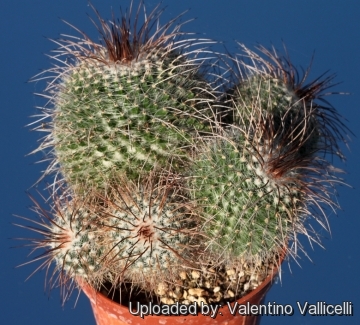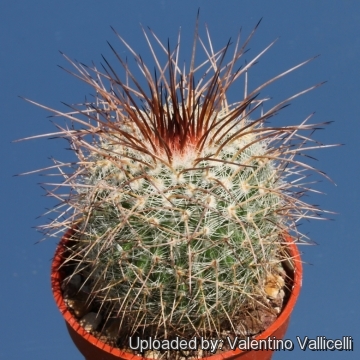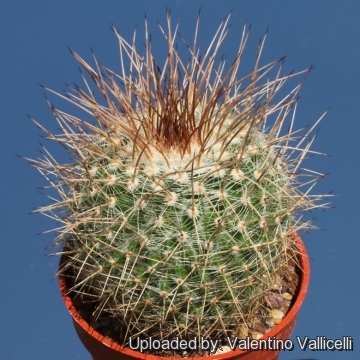




Your support is critical to our success.

ML195 (Collector Michel Lacoste) El Campanario, Calipam, Puebla, Mexico. Altitude 1400 metres above sea level.
Origin and Habitat: Mammillaria variaculeata is endemic to the southern portion of the Mexican State of Puebla on the Oaxaca border (Mexico, Northern America)
Altitude: 1300-1400 metres above sea level.
Habitat: The species grows in tropical deciduous forest together with Mammillaria dixanthocentron, Ferocactus recurvusSN|4280]]SN|4280]], Coryphantha calipensisSN|10082]]SN|10082]], and Neobuxbaumia tetetzoSN|6411]]SN|6411]]. The species is relatively abundant, however, the threats are unknown.
Synonyms:
- Mammillaria varieaculeata Buchenau
SPANISH (Español): Biznaga de espinas variables
Description: Mammillaria varieaculeataSN|17002]]SN|17002]] (also spelled variaculeata) is a clumping cactus forking dichotomously (or basally) at maturity. The species is described as dimorphic, with a rather uninteresting short-spined juvenile form, before making a fierce and very showy mature dark brown spination. However the species comprises plants with variable spine length, in the same area it is possible to find both plant with short spines and long spines. Moreover, within the same clump, despite identical dimensions, the individual heads can acquire the definitive character at very different ages.
Habit: Plants forming large clusters or mounds.
Stem: Globose to short cylindrical, curving pipe-shaped, ranging from green to dark green, to 13 cm or more high and 9 cm in diameter.
Tubercles: Closely set, pyramidal, firm, axils with 10-25 white bristles 4-8 mm long.
Areoles: Large, roundish whitish, at first woolly later almost naked.
Central spines 1-5, fewer with age, needle-like, slightly bent, light brown, becoming darker and stonger with age, 5-10 mm at first, later to 25 mm (or more) long.
Radial spines: 17-24, finely needle-like, white, yellowish brown basally, later dark brown, 4-8 mm long.
Flowers: Diurnal, small, funnelform, red, up to 15 mm long, and in diameter, rarely rising above the spines.
Blooming season: Not known.
Fruits: Club shaped, scarlet, 15-20 mm long.
Seeds: Small, brown.
Bibliography: Major references and further lectures
1) Edward Anderson “The Cactus family” Timber Press, Incorporated, 2001
2) James Cullen, Sabina G. Knees, H. Suzanne Cubey "The European Garden Flora Flowering Plants: A Manual for the Identification of Plants Cultivated in Europe, Both Out-of-Doors and Under Glass" Cambridge University Press, 11/Aug/2011
3) David R Hunt; Nigel P Taylor; Graham Charles; International Cactaceae Systematics Group. "The New Cactus Lexicon" dh books, 2006
4) John Pilbeam “Mammillaria: the cactus file handbook” Cirio Publishing Services Ltd Dec/30,/1999
5) Ulises Guzmán, Salvador Arias, Patricia Dávila "Catálogo de cactáceas mexicanas". Universidad Nacional Autónoma de México, Mexiko-Stadt 2003
6) Arias, S. & Zavala-Hurtado, A. 2013. Mammillaria variaculeata. The IUCN Red List of Threatened Species. Version 2014.3. <www.iucnredlist.org>. Downloaded on 20 May 2015.

ML195 (Collector Michel Lacoste) El Campanario, Calipam, Puebla, Mexico. Photo by: Valentino Vallicelli

Calipán, Puebla, Mexico Photo by: Valentino Vallicelli

Mammillaria varieaculeata Photo by: Valentino Vallicelli
The gallery now contains thousands of pictures, however it is possible to do even more. We are, of course, seeking photos of species not yet shown in the gallery but not only that, we are also looking for better pictures than those already present. Read More...
Cultivation and Propagation: Mammillaria varieaculeataSN|17002]]SN|17002]] is a freely clustering species that reproduces easily by cutting. It is a great starter plant for the cactus grower, that readily builds up into a dense cluster of stems smothered by white hairs, further decorated by rings of cream or pale pink blooms.
Growth rate: It is a rapidly growing species. It offset from the base and can fill a 25 cm pot in just a few years given the best conditions.
Soils: It likes very porous standard cactus mix soil with little organic matter (peat, humus).
Repotting: Repotting every 2-3 years. As it is prone to rot under-pot in a smaller container filled with very porous compost. Use pot with good drainage.
Watering: Water regularly in summer, but do not overwater (very wet-sensitively, especially in light of its succulent root system). Its roots are easily lost in pots that stay damp for any length of time. Keep dry with ample airflow in winter. In the rest period no high atmospheric humidity!! Care must be taken with watering as they tends to become swollen and untidy in growth habit if given too much water and shade.
Fertilization: During the growing season enrich the soil using a fertilizer rich in potassium and phosphorous, but poor in nitrogen, because this chemical element doesn’t help the development of succulent plants, making them too soft and full of water.
Hardiness: It is quite frost resistant if kept dry, hardy as low as -5° C (some reports give it hardy to -5°C). However some warmth throughout the year will increase the grower's success (minimum 5° to 8°C during rest season).
Exposition: Outside bright sun, filtered sunlight or afternoon shade, inside it needs bright light, and some direct sun. Subject to sunburn if exposed to direct sun for too long. Tends to bronze in strong light, which encourages flowering and heavy wool and spine production.
Uses: It is an excellent plant for container growing. It always looks good and stays small. It look fine in a cold greenhouse and frame.
Traditional uses: The white, hooked spines of this spherical cactus were used as fish hooks in its native Mexico.
Pests & diseases: It may be attractive to a variety of insects, but plants in good condition should be nearly pest-free, particularly if they are grown in a mineral potting-mix, with good exposure and ventilation. Nonetheless, there are several pests to watch for:
- Red spiders: Sensitive to red spider mite. Overhead watering is helpful in controlling mites.
- Mealy bugs: Occasionally mealy bugs they develop aerial into the new growth among the wool with disfiguring results, but the worst types develop underground on the roots and are invisible except by their effects.
- Scales: Scales are rarely a problem.
- Rot: Rot it is only a minor problem with cacti if the plants are watered and “aired” correctly. If they are not, fungicides won't help all that much.
Propagation: Direct sow after last frost or (usually) or division . Seeds germinate in 7-14 days at 21-27° C in spring, remove the glass cover gradually as the plants develops and keep ventilated, no full sun for young plants! The seedlings should not be disturbed until they are well rooted, after which they can be planted separately in small pots. Cuttings: wait until the offsets that appear at the base of old clustered specimens are 1/3 the size of the parent and then detach and plant. Cuttings will take root in a minimum temperature of 20° C (but better in hot weather). Cuttings of healthy shoots can be taken in the spring and summer. Cut the stem with a sharp, sterile knife, leave the cutting in a warm, dry place for a week or weeks (depending on how thick the cutting is) until a callus forms over the wound. Once the callus forms, the cutting may be inserted in a container filled with firmed cactus potting mix topped with a surface layer of coarse grit. They should be placed in the coarse grit only; this prevents the cut end from becoming too wet and allows the roots to penetrate the rich compost underneath. The cuttings should root in 2 to 6 weeks.
| Your Actions | |
|---|---|
| Back to Mammillaria index | |
| Back to Cactaceae index | |
 |
Back to Cacti Encyclopedia index |
Privacy stantement - Terms and conditions - How to cite - About us - Feedback - Donate



